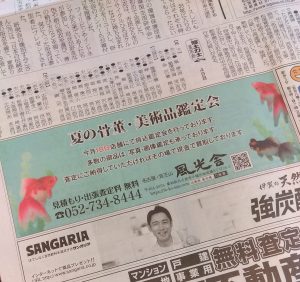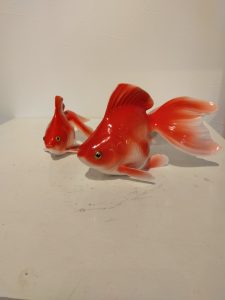意外とひねりのないネーミングでした(愛知県名古屋市千種区姫池通 骨董買取 古美術風光舎)
2024.07.30
みなさまこんにちは、スタッフTでございます。
朝からセミの鳴き声で起こされ少々寝不足気味です。今日も暑いですね…。
ところで、お気づきになった方いらっしゃいますでしょうか…
古美術風光舎の朝日新聞紙面広告が、夏バージョンに衣替えいたしました!。

夏の紙面は、薄い青の涼しげな水面に金魚がゆらゆらと泳いでおります。
紙面にて、はっと目に留まる鮮やかなそして涼しげな青に金魚、見掛けられた際には、しばし癒されていただけましたら幸いでございます。
「金魚」といえば、子どもの頃、お祭りで楽しみにしていたのが「金魚すくい」でした。すくえるかどうかドキドキする瞬間や、何匹すくえるか競争した光景は、今でも鮮明に思い出されます。
金魚すくいは、日本の縁日文化のひとつとして、古くから親しまれてきた遊びです。江戸時代には既に存在し、浮世絵や錦絵に描かれていたものが記録として残っています。当時は高貴な人々が楽しんだ遊びでもあったんだとか。その頃から、金魚独特の美しい姿と動きが人々を魅了していたことがわかりますね。
金魚すくいに欠かせないのが、「ポイ」と呼ばれるすくい網です。
ちょっと変わった言葉ですよね。ですがこの「ポイ」が、正式名称です。
「ポイ」という言葉自体は、「たばこのポイ捨て」などというように、動作を表す言葉、しかも、「軽い気持ちで捨てる」という意味を持った動作として用いられます。
実は「ポイ」の由来も同じで、金魚すくいで破れたら、すぐに「ポイっと捨てる」から、「ポイ」。
ちょっと失礼ですが、なんともひねりのないネーミング(笑)
金魚をポイポイすくうから「ポイ」と名付けられたという説もあるようですが、全国金魚すくい大会事務局では、「ポイッと捨てる」説を由来としているそうです。
「ポイ」と言われて思い浮かべるのは、プラスチックの枠に薄い紙が貼ってある物ですよね。実は「ポイ」には、もう一種類あるんです!
私は初めて知りましたが、「もなか」を使用しているところもあるのを知っていましたか?
もなかって、あんこやスイーツで食べるイメージしかありません・・・
北海道の一部では、この「もなか」を使用して金魚すくいをするところもあるそうです。紙以上に水に溶けやすいため難易度は高そうです。
これで金魚すくいなんて厳しいに決まっている…。
それに、水槽の中が、溶けたもなかだらけになってしまいます。そんなこともあって、水槽が汚れない紙のポイが、段々と主流になっていったようです。
それまでつかみ取りや、網ですくうだけで、持ち帰ることができなかった金魚すくいが、持ち帰るようになるのは明治時代後期の頃になります。ここで「ポイ」が誕生するのです。
これまでのようにつかみ取りや網ですくう方法では、たくさんすくえてしまうため、商売にならなくなったわけです。金魚をすくいにくくするために、考え出されたのが「ポイ」だったのですね。
初期のポイは針金で作った枠に和紙を貼り付けたもので、使い捨てではなく、破れたら和紙を取り替えていました。
プラスチック製の「ポイ」が出始めるようになったのは、昭和30年代に入ってからなのだそうですよ。
いつの時代も人々を魅了する「金魚すくい」ですが、ポイが破れないかとハラハラする子どもの横で、すくった後のことを考える大人の側としては、「それ以上すくってくれるな」と別の意味でハラハラしていたのは私だけではないと思います。
ではでは、また。

Hello everyone, this is Staff T.
I was woken up by the sound of cicadas in the morning, and I am a little sleep deprived. It’s hot again today…
By the way, I wonder if any of you have noticed…
We have changed our advertisement in the Asahi Shimbun newspaper to a summer version!
The summer version features a goldfish swimming in the cool, pale blue water.
We hope that you will be comforted by the vivid and cool blue goldfish that catch your eyes when you see them on the paper.
Speaking of goldfish, when I was a child, I used to look forward to “goldfish scooping” at festivals. I still vividly recall the thrilling moment when I wondered if I would be able to scoop the goldfish, or the scene of competing to see how many goldfish I could scoop.
Goldfish scooping has long been a popular game as part of Japan’s fair culture. It already existed in the Edo period (1603-1867), and records of the game can be found in ukiyoe (woodblock prints) and nishikie (woodblock prints). It was also a game enjoyed by noble people at that time. You can see that even back then, people were attracted by the uniquely beautiful appearance and movements of goldfish.
An indispensable part of goldfish scooping is a scooping net called “poi.
It is a bit of a strange word, isn’t it? However, this “poi” is the official name.
The word “poi” itself is used to describe an action, such as “littering cigarettes,” and it is also used as an action that means “to throw away with a light heart.
In fact, the origin of the word “poi” is the same: “poi” comes from the word “poit,” which means “to throw away” immediately after a goldfish scoop is torn.
It’s a bit rude, but it’s a name without a twist (laughs).
There is a theory that it was named “poi” because people scoop goldfish, but the National Goldfish Sukui Festival Office says that the origin of the name comes from the theory of “poi-poi” meaning “to throw away with a plop.
When you hear the word “poi,” what comes to mind is a thin piece of paper attached to a plastic frame. Actually, there is another type of “poi!
I had never heard of it before, but did you know that some places use “moi”?
I only have an image of “monaka” as a kind of bean paste or sweets…
In some parts of Hokkaido, this “monaka” is used to scoop goldfish. It seems to be more difficult than paper because it is more soluble in water.
Scooping goldfish with this is a tough task, of course….
Besides, the inside of the aquarium would be covered with melted monaka. Because of this, paper ladders, which do not contaminate the aquarium, gradually became the mainstream.
Goldfish scooping, which until then was limited to catching goldfish or scooping them with a net and not being able to take them home, became a tradition in the late Meiji period (1868-1912).
It was here that the “poi” was born!
The traditional methods of grabbing goldfish and scooping them with a net no longer worked for business because so many goldfish could be scooped. In order to make it more difficult to scoop goldfish, the poi was invented.
Early poi were made of Japanese paper attached to a frame made of wire, and were not disposable.
It was not until the 1950s that plastic “poi” began to appear.
Goldfish scooping has always fascinated people, but I don’t think I am the only one who is on edge as an adult thinking about what to do after catching the fish, while the children are on edge wondering if the poi will tear.
See you later.
*******************
ご実家の整理やお片付けなどをされている方のご相談などが多くございます。
お片付けなどくれぐれもご無理のないようになさってくださいませ。
風光舎では古美術品や骨董品の他にも絵画や宝石、趣味のお品など様々なジャンルのものを買受しております。
お片付けをされていて、こういうものでもいいのかしらと迷われているものでも、どうぞお気軽にご相談下さいませ。
また風光舎は、出張買取も強化しております。ご近所はもちろん、愛知県内、岐阜県、三重県その他の県へも出張いたします。
まずは、お電話お待ちしております。
愛知県名古屋市千種区姫池通
骨董 買取【古美術 風光舎 名古屋店】
TEL052(734)8444
10:00-18:00 OPEN
#出張買取#骨董#古美術#骨董品#絵画#版画#茶道具#刀剣#彫刻

